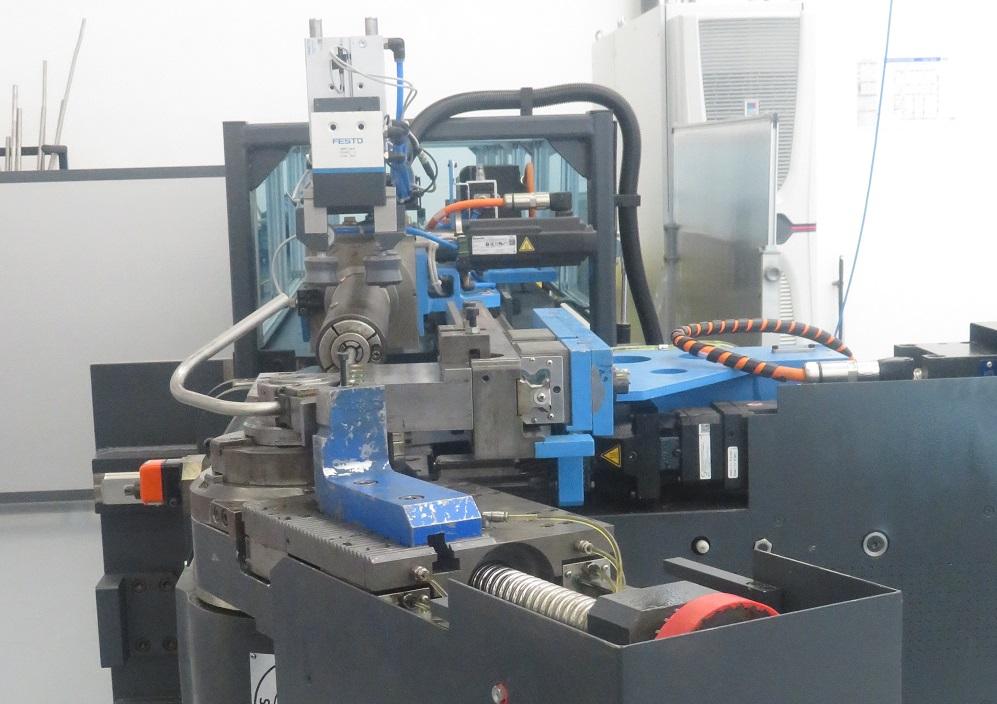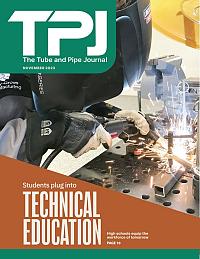Senior Content Manager
- FMA
- The Fabricator
- FABTECH
- Canadian Metalworking
Categories
- Additive Manufacturing
- Aluminum Welding
- Arc Welding
- Assembly and Joining
- Automation and Robotics
- Bending and Forming
- Consumables
- Cutting and Weld Prep
- Electric Vehicles
- En Español
- Finishing
- Hydroforming
- Laser Cutting
- Laser Welding
- Machining
- Manufacturing Software
- Materials Handling
- Metals/Materials
- Oxyfuel Cutting
- Plasma Cutting
- Power Tools
- Punching and Other Holemaking
- Roll Forming
- Safety
- Sawing
- Shearing
- Shop Management
- Testing and Measuring
- Tube and Pipe Fabrication
- Tube and Pipe Production
- Waterjet Cutting
Industry Directory
Webcasts
Podcasts
FAB 40
Advertise
Subscribe
Account Login
Search
Tube benders help keep aircraft parts flying well
Moroccan fabricator uses bending machines to maintain accuracy
- By Anja Ehrmann
- November 9, 2023
- Article
- Tube and Pipe Fabrication

TDM uses an independent bend die axis feature, which allows the bending head to be moved flexibly to the left or right side, for approximately 20% of the components it manufactures.
Fabricating tubes for aircraft can be tricky business. Even the smallest defects can have fatal consequences. Leaks in hydraulic tubes, for example, can prevent the landing gear from extending and the aircraft from landing. Fuel leaks from a tube could even cause a fire.
Accordingly, aircraft manufacturers place high quality and safety demands on their Tier 1 suppliers. Not only are the components subjected to exacting controls, for example, but the entire production process also has to be validated.
Tubes and Ducts Maroc Aerospace (TDM), founded in Morocco in 2018 by H2E, a U.S.-based aerospace advisory firm led by Jürgen Viehrig and Lou Winoski, knows those challenges well. The company fabricates tube systems for the aerospace industry and acts as a Tier 1 supplier for multiple well-known aircraft manufacturers.
Headquartered at Casablanca’s Mohammed V Airport, TDM employs 70 people and has become something of a showpiece in the North African country’s strategy to become a major global location for aerospace system and module suppliers. The company has obtained numerous qualifications in recent years and also fulfills, for example, the quality management system standard DIN EN 9100, which applies specifically to aviation.
Production at TDM is subject to strict regulations, compliance with which is checked and audited on-site on behalf of the aircraft manufacturer. In this context, there are also separate requirements for the manufacturer of the bending machines that TDM uses to fabricate tube systems for aircraft.
Finding a Partner with Experience
Viehrig and Winoski have more than 60 years of experience in tube manufacturing for the aerospace industry. For the demanding production of tube systems for hydraulic lines—as well as cooling water, wastewater, and brake lines—in aircraft, they were looking to find a manufacturer of tube bending machines with many years of expertise in the aerospace industry.
“We needed a partner who could support us not only with high-quality technology, but also with expert advice,” said Viehrig, CEO. “Schwarze-Robitec***schwarze-robitec.com*** has been active in this field for more than 50 years and knows the special requirements regarding surface finish, wall thickness, and ovality down to the last detail.” For example, tubes must be manufactured so that they are completely wrinkle-free.
The company purchased two Aircraft Edition tube bending machines from Schwarze-Robitec: a single-stack CNC 40 E TB and a CNC 40 Rotary with a rotating bending head. The machines can bend titanium and stainless steel tubes with diameters from 6.35 to 31.75 mm.
Lean Manufacturing in a Modern Factory
At TDM’s new production plant, the tubes first are cut to size, then bent and measured. This is followed by grinding, polishing, and joining the tubes with fittings in an orbital welding process. Operators then inspect the tubes with a digital X-ray machine and pressure-test them before they cleaning and drying them. Finally, they’re marked before going through one last quality assurance stop before they’re packed and shipped.
“We have the capacity to produce 400,000 tubes a year,” Viehrig said. “Here, we focus not on the production of replacement or special parts but rather on semiautomated and lean production in large series.”

For particularly complex geometries such as coiled tubing, the CNC 40 Rotary is used with an independent axis for the bend die. Images: TDM Aerospace
The aircraft manufacturer that TDM supplies produces several aircraft in a month, with about 600 different tube systems required for each one. To increase efficiency, TDM bundles its capacities by manufacturing in batches of one to 10, delivering the required quantity and storing the remaining components until the next order.
For particularly complex geometries, TDM uses its CNC 40 Rotary machine, which has an independent axis for the bend die. The company uses this option of flexibly moving the bending head to the left or right side for about 20% of the components it bends on the machine. In so doing, TDM can produce multidimensional tube systems—such as coiled tubing and pocket tubes in the shape of an angular U used in aircraft to compensate for expansion and vibration—precisely and reliably, without welding, in a single work step.
Thin Walls = Demanding Material
TDM’s fabrication requirements typically are exacting: Not only do the tubes that it bends have relatively large diameters and thin walls, but they’re almost always made of titanium, a material prized for its high strength.
That strength makes titanium ideal for aircraft, but it’s also brittle and cracks easily. So the bending process must be very slow and vibration-free. Even with wall thicknesses of 0.56 to 0.88 mm, the demand is that no cracks or folds occur during bending.
“From a purely technical point of view, this is a major challenge,” said Philipp Knobloch, global sales director for new machinery equipment at Schwarze-Robitec. “A high torque is required to achieve a smooth movement, but the slowness of the motion means there is a risk of vibrations occurring, which can lead to wrinkles.” TDM uses wiper dies help to counter this.
Special attention also must be paid to surface finish: The percentage of dents, scratches, wrinkles, and notches must not exceed 1% depth, measured against the tube diameter. On top of that, ovality must be less than 3% because the tubes must have almost perfect roundness to ensure ideal flow properties.
Precision Counts
Knowing the demand for precision, Schwarze-Robitec aspires to do what it can to assist its customers with the bending machines in its Aircraft Edition.
“The accuracy can be increased even further through targeted control of the axes and amounts to +/- 0.05 mm,” Knobloch said. “For the orientation angle and bending accuracy, the result is 0.05 degree.”
The tube bending machines also are designed for use under continuous and long-term stress. This helps to ensure reliable operation without malfunctions or unnecessary interruptions—something that is particularly advantageous in countries with weak infrastructure where there is no close-knit network of specialist companies on standby in the event of disruptions.
“The results speak for themselves: Ovality is less than 3% and the surfaces are excellent—completely wrinkle- and scratch-free,” Viehrig said. “At the same time, we achieve very precise results with low tolerances, even with our most complicated tube geometry with 16 bends.”
Support Beyond Initial Operation Before TDM contracted Schwarze-Robitec for its machines in 2019, a preliminary acceptance test was carried out at the German machine manufacturer’s plant in Cologne. TDM then put the bending machines into operation in Casablanca in early 2020.
Included in the delivery was a photometric measuring cell that can be used to determine parameters like tube geometries, lengths between bends, and bending angles. Following the commissioning, TDM employees received extensive on-site training, with follow-up training taking place several months later.
“One of the biggest challenges was that we had to implement production here on site without skilled workers,” Viehrig said. “This meant that training was crucially important for us. In Schwarze-Robitec, we found a reliable partner who actively supported us beyond delivery and commissioning.”
Over the next few years, TDM intends to expand its capacities and is therefore planning to install up to three more tube bending machines. In doing so, the company hopes to continue working with Schwarze-Robitec for the foreseeable future.
About the Author
About the Publication
Related Companies
subscribe now

The Tube and Pipe Journal became the first magazine dedicated to serving the metal tube and pipe industry in 1990. Today, it remains the only North American publication devoted to this industry, and it has become the most trusted source of information for tube and pipe professionals.
start your free subscription- Stay connected from anywhere

Easily access valuable industry resources now with full access to the digital edition of The Fabricator.

Easily access valuable industry resources now with full access to the digital edition of The Welder.

Easily access valuable industry resources now with full access to the digital edition of The Tube and Pipe Journal.
- Podcasting
- Podcast:
- The Fabricator Podcast
- Published:
- 04/16/2024
- Running Time:
- 63:29
In this episode of The Fabricator Podcast, Caleb Chamberlain, co-founder and CEO of OSH Cut, discusses his company’s...
- Trending Articles
Zekelman Industries to invest $120 million in Arkansas expansion

3D laser tube cutting system available in 3, 4, or 5 kW

Corrosion-inhibiting coating can be peeled off after use

Brushless copper tubing cutter adjusts to ODs up to 2-1/8 in.

HGG Profiling Equipment names area sales manager

- Industry Events
16th Annual Safety Conference
- April 30 - May 1, 2024
- Elgin,
Pipe and Tube Conference
- May 21 - 22, 2024
- Omaha, NE
World-Class Roll Forming Workshop
- June 5 - 6, 2024
- Louisville, KY
Advanced Laser Application Workshop
- June 25 - 27, 2024
- Novi, MI



























